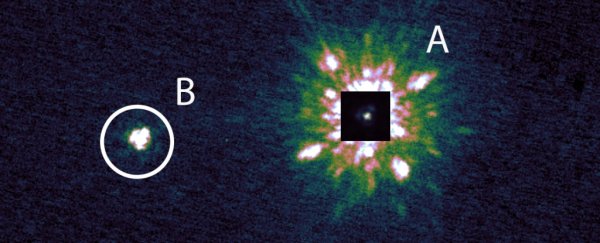A new clue has just been found that could help solve the mystery of a weirdly dimming star. KIC 8462852, also known as Boyajian's Star, seems to have a binary companion that could be contributing to its irregular dips in brightness.
If confirmed with more detailed observations, the newly discovered companion star could help astronomers finally solve KIC 8462852's ongoing mystery.
The star was discovered in 2015 by astronomer Tabetha Boyajian (hence it was previously Tabby's Star), and since then it has proven to be a real puzzle. It's a yellow-white dwarf star around 1,470 light-years away, and it keeps dimming erratically. There is no regularity either to the timing of the star's dimming, or the depth - some of the dips in starlight have been as deep as 22 percent.
This behaviour rules out planets; when an exoplanet passes between a star and Earth as it orbits, it will dim the star by a tiny amount - 1 percent or less - at regular intervals.
Furthermore, when Boyajian's Star dims, some wavelengths are blocked more than others. That rules out a solid object (such as an alien megastructure, as proposed in 2016), which would block all wavelengths equally.
So far, the most likely explanation seems to be optically thin dust and debris, possibly from broken-up planetesimals or comets on eccentric orbits, in combination with normal brightness variations from the star itself.
The presence of a binary companion star on a wide orbit could help explain the presence of all this material, providing additional gravitational perturbations to disrupt orbiting bodies.
Since 2016, a team of astronomers led by Logan Pearce of the University of Arizona has been trying to confirm the potential connection of a nearby star to KIC 8462852. Their paper has now been accepted into The Astrophysical Journal.
The difficulty of measuring space in three dimensions is what's made this work rather hard. Stars that look quite close together might actually be at wildly different distances from the viewer. So, Pearce and team used five years' worth of observations to make precise astrometric measurements of the faint star that seemed close to KIC 8462852.
"In this work we use three epochs of Keck/NIRC2 astrometry spanning five years to revisit the status of the close companion to KIC 8462852, and show that they are a common proper motion pair and a gravitationally bound binary system," they wrote in their paper.
In addition to the Keck Observatory observations, the 2020 release of astrometric data from the Gaia satellite - the most complete and precise three-dimensional map of the Milky Way to date - also included the faint star, with measurements in agreement with the team's findings.
The two stars are separated by a distance of 880 astronomical units. Boyajian's Star, or KIC 8462852 A, is the bigger star, at around 1.36 times the mass and 1.5 times the size of the Sun. The companion, KIC 8462852 B, is a red dwarf star around 0.44 times the mass and 0.45 times the size of the Sun.
At such a wide orbit, KIC 8462852 B would be unlikely to have any direct effect on the brightness of KIC 8462852 A. But it could still play a role in the larger star's mystery fluctuations, the researchers said.
"The binary companion may influence the long-term evolution of the system," they wrote in their paper.
Scientists have previously found that widely spaced stellar binaries can be pushed by larger gravitational forces to move in very close to their mutual centre of mass multiple times over the course of around 10 billion years.
In turn, this could result in the disruption of planets and other small orbiting bodies where they're stretched and torn apart by gravitational interactions, resulting in clouds of debris.
The scenario is yet to be confirmed. At such a wide separation, the two stars would have an extremely long orbit, and the observations taken were not sufficient to characterise this orbit. KIC 8462852 B could be a star that was ejected from the system; or the two stars could be members of a co-moving group.
The researchers believe that a binary is the most likely explanation for their measurements of the two stars, but future measurements of the pair will be needed to better understand their relationship. This could help confirm or rule out KIC 8462852 B's role in the star's erratic brightness.
But for all the mystery lovers out there, never fear. There are other weirdly dimming stars out there, including a star for which the binary companion has already been accounted for, and a tantalising collection of 21 stars that could be even weirder.
The team's research has been accepted into The Astrophysical Journal, and is available on arXiv.
